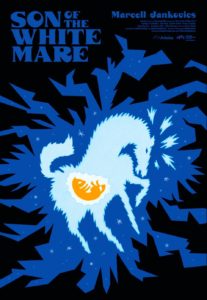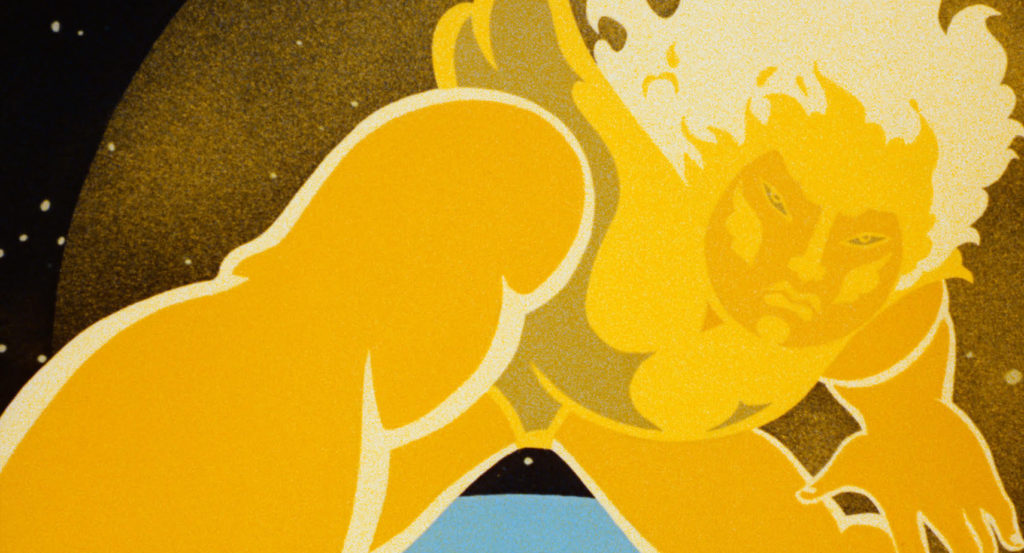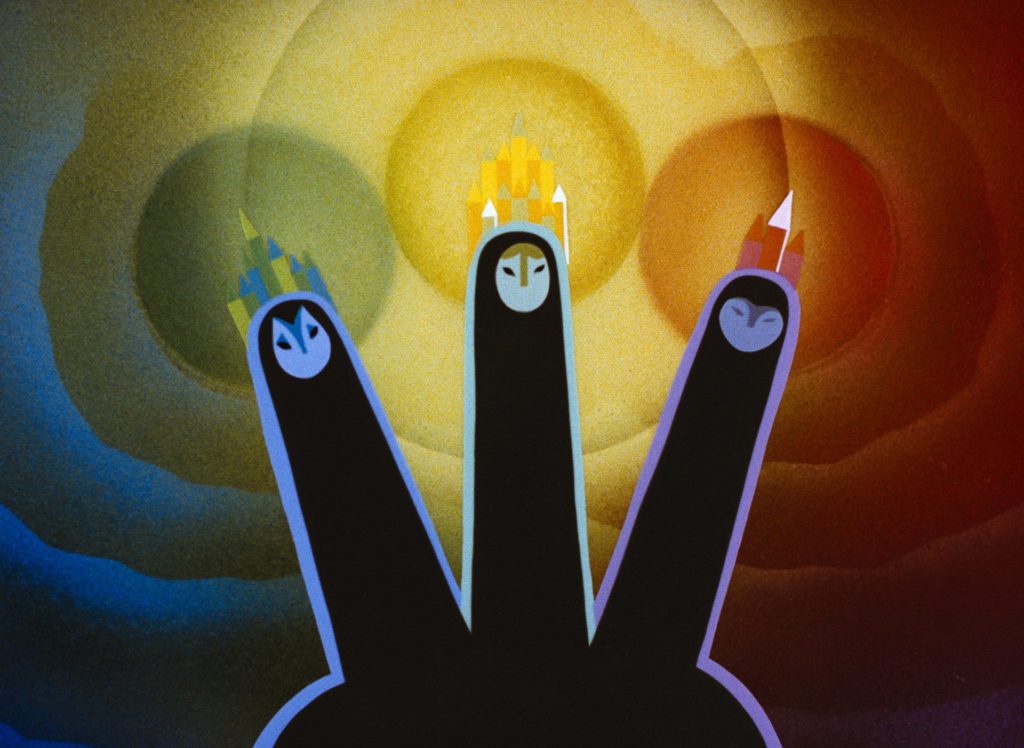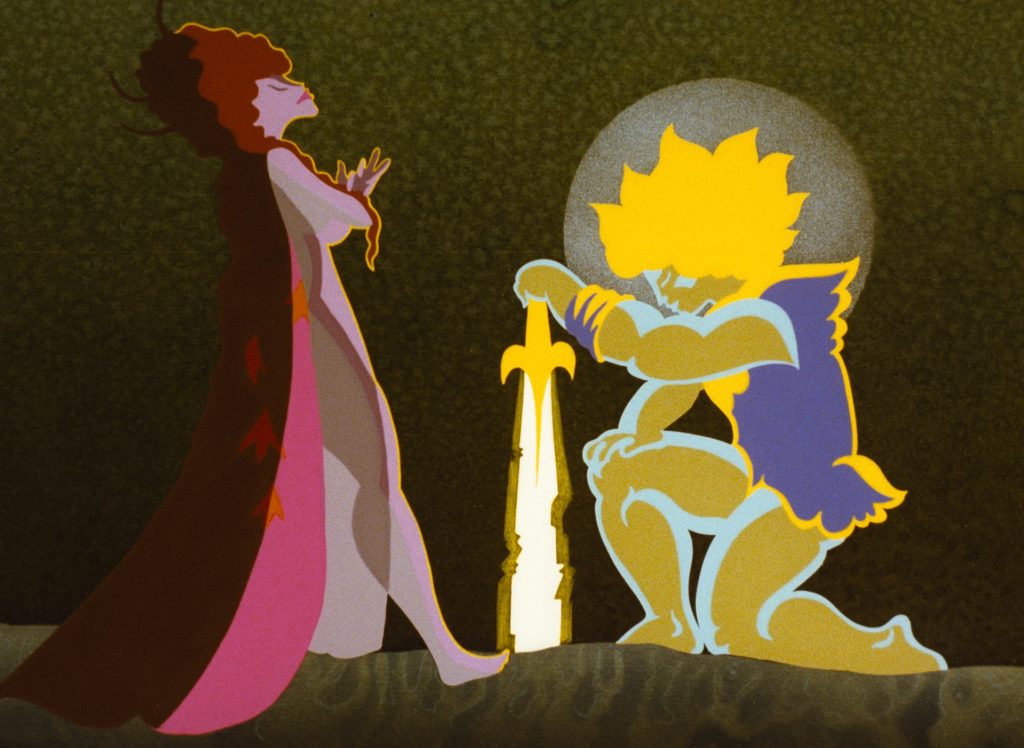A Mythic Classic of Hungarian Animation Returns
MARCELL JANKOVICS/HUNGARIAN/1981

“Once upon a time…” says the mare to her child, the first lines uttered in one of the most singular, magical experiences of all time. That experience is Marcell Jankovics’s Son of the White Mare (Fehérlófia), making it’s US premiere courtesy of Arbelos Films, is one of most marvelous myths ever brought to the screen. Stylistically without precedent or successor, Jankovics’s second feature is a loving tribute to the mythology and legends of numerous Steppe peoples as compiled by narrative poet László Arany.
Jankovics, best known in the US for his 1974 Oscar-nominated short “Sisyphus”, is one of the great unsung masters of animation. Only with the advent of the internet and increased availability of his work has Jankovics finally begun to receive the acclaim he rightfully deserves. Starting at Hungary’s Pannonia Film Studio in the 60s, Jankovics rose from in-between artist to director in only a few years.
In 1973 Jankovics directed Johnny Corncob (János vitéz), Hungary’s first animated feature film. This first feature provided a ground for Jankovics to experiment with form and movement, borrowing and putting his own spin on aesthetic elements from Yellow Submarine. It also allowed Jankovics the opportunity to develop his skills in longform storytelling and in adapting regional mythology and literature, a quality shared by much of his work.
And from this background came 1981’s Son of the White Mare. Loosely derived from the story of the same name, Son of the White Mare tells the tale of the third son of the eponymous White Mare, Treeshaker. He is told the story of the once peaceful world, and of how three Dragons were unleashed, ending the reign of the Forefather and slaying the three Princes of the land. Each dragon then took one of the three Princesses as their bride, before casting out the Progenetrix, her form transformed into that of the mare.

Incensed, the young Treeshaker is determined to grow strong and face the Dragons. For many years he works, before finally leaving his home as a young man on a quest to enter the Underworld, slay the dragons, free the princesses, and take back the stolen kingdom. On the way he encounters his brothers, Stonecrumbler and Ironkneader, who join him on his journey, before travelling alone into the maw of the Underworld and finally confronting the Dragons.
Despite what may at a glance appear to be a traditional fantasy story, Son of the White Mare presents the tale in a fashion more reflective of the original mythology. Things are not altered greatly to make them more palatable to modern audiences. Some interludes that might seem strange like Treeshaker drinking the milk of his mother to grow stronger or Treeshaker gathering oxen and wine for a Griffon add to the authenticity, the sense of myth.
Son of the White Mare also avoids the trap of being overly self-serious despite its arthouse qualities, again adapting more absurd elements for comic effect. The stand out of these is an interlude involving a gnome who torments the brothers at camp; eating their porridge and making it look like the brother who remained behind greedily ate it all himself, which of course results in the “guilty” brother receiving a spanking from the other two.

All these stylistic and mythic idiosyncrasies might seem out of place in a Disney style “Illusion of Life” animated film, but thrive in Jankovics’s vivid, psychedelic fantasy realm. The Dragons especially deserve attention, not looking like traditional European interpretations of Dragons in the slightest, and perfectly complementing the irreality and wonderful strangeness of the feature. One is a hulking three headed monster of stone, one a mass of guns and rockets on tank treads, and the last a cityscape of skyscrapers with windows lighting up to make its facial expressions. Humanoid forms are impressionistic, featuring exaggerated proportions that make them recognizable as their designs remain simplistic yet still vividly realized. Black outlines are eschewed outside of characters with black featured heavily in their palette, allowing contrasting colors in the beautiful, geometric backgrounds making the lineless figures pop all the more. Symmetry abounds both visually and thematically, as characters exist within circular frames, all as the film intends to tell a classic story of cycles.
The actual animation of the piece is also a visual feast, combining both surreality with gorgeous figure movements. Characters and backgrounds writhe and morph, both as transitions between scenes and physical changes within the fiction. Characters’ faces will split to address others on both sides of them, shattered links of chain will turn into hunters, or a young foal will become a human child. However, the human movement is captured gorgeously, with muscles often tensing as Treeshaker and his brothers do their work, much in the fashion of “Sisyphus”. The Princesses too move with beauty and grace, their body and clothes moving distinctly and fluidly in a fashion that reflects their personalities and designs.
The soundtrack for the film is another oddity, but an excellent one. In place of orchestral music that one might expect for a myth, the film instead opts for a highly synthetic score. But it is artfully done, often quite low-key and more in line with earlier experimental synthesizer music. The strange score manages to perfectly complement the film, adding to the sense of wonder it imbues in its audience fabulously.

The film’s remaster courtesy of Arbelos Films and the Hungarian National Film Archive is a treasure. While previous video releases were washed out and featured excessive brightness, this version of the film is beautifully presented. Subtle variations in color immediately pop, and the deeper saturation adds warmth to many scenes, finally allowing viewers an ideal version of Jankovics’s masterpiece. Arbelos, who previously presented an excellent release of the psychedelic animated classic Belladonna of Sadness are doing incredible work releasing some wonderful animated gems, and I can only hope they continue this trend.
In case it’s not readily apparent, Son of the White Mare is, to me, one of the greatest films of all time. A vision that is wholly its own, it combines a fascinating mythology with some of the most gorgeous visuals ever conceived, all brought to life through inventive and gorgeous animation. I am thrilled to see it finally released in the United States, and cannot thank Arbelos enough for their wonderfully restored release. While I recognize it may not be to every viewer’s taste, it’s such an incredible work of art that I find myself unable to find comparison to, and I sincerely believe that everyone should experience it at least once.
Son of the White Mare is currently screening in virtual cinemas, with a Blu-Ray release scheduled for later in 2020. For those who would like to support one such cinema, the ever wonderful Webster Film Series, simply follow the link provided here.

